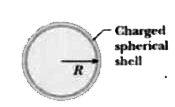In Fig. 24-28, a thin conducting spherical shell of radius R=2.00 cm has a uniformly spread surface charge of q=−5.00×10−15C. What are the electric potential and magnitude of the electric field on (a) the surface and at (b) r=2.00R and (c ) r=0.500R?

For points on or outside a uniform spherical distribution of charge, the potential and held are the same as if the charge were concentrated as a particle at the center of the actual distribution. Thus, the potential is
V=kqr, (24−40)
where r is the radial distance and k=1/4πε0, and the field has the magnitude
E=k|q|r2 (24−41)
From Gauss. law, we know that in the empty hollow of the shell, the electric field is zero because an interior Gaussian sphere would enclose no charge and thus have no electric flux through it. A change in potential between two points is equal to the negative of the integration of the electric field along a path between those points:
Vf−Vi=−∫fi→E.d→s, (24-42)
On the surface: From Eqs. 24-40 and 24-41, the potential and field magnitude at r=R are
E=(8.99×109N.m2/C2)∣∣5.00×10−15C(0.0200m)2
=0.112V/m (Answer)
V=(8.99×109N.m2/C2)5.00×10−15C0.0200m
=2.25×10−3V=2.25mV (Answer)
Outside the surface: From those same two equations, with r=2.00R=0.0400 m, we have
E=(8.99×109N.m2/C2)∣∣5.00×10−15C∣∣(0.0400m)2
=2.81×10−2V/m
V=(8.99×109N.m2/C2)5.00×10−15C0.0400m
=1.12×10−3V=1.12mV (Answer)
Inside the empty shell: Because the hollow contains no charge, Gauss. law tells us that for any point inside the hollow
E=0. (Answer)
To find the potential in the hollow, we use Eq. 24-42, integrating from any interior point ( call it point i) to the surface (call it point!). Substituting E = 0, Eq. 24-42 simply boils down to
Vf−Vi=−∫fi0d→s
2.25×10−3V−Vi=0
Vi=2.25×10−3V=2.25mV (Answer)
In words, the interior potential is the same as the surface potential because there is no internal electric field inside the empty hollow.
Topper's Solved these Questions
- ELECTRIC POTENTIALBOOK - RESNICK AND HALLIDAYCHAPTER - ELECTRIC POTENTIALEXERCISE - SAMPLE PROBLEM 24.15 Point charge projected from a large distance towards center of fixed charged ring
1 Videos
- ELECTRIC POTENTIALBOOK - RESNICK AND HALLIDAYCHAPTER - ELECTRIC POTENTIALEXERCISE - SAMPLE PROBLEM 24.16 Finding the field from the potential
1 Videos
- ELECTRIC POTENTIALBOOK - RESNICK AND HALLIDAYCHAPTER - ELECTRIC POTENTIALEXERCISE - SAMPLE PROBLEM 24.13 Potential at the surface of the outer shell
1 Videos
- ELECTRIC CHARGES AND FIELDSBOOK - RESNICK AND HALLIDAYCHAPTER - ELECTRIC CHARGES AND FIELDSEXERCISE - Practice Questions (Integer Type )
3 Videos
- ELECTROMAGNETIC INDUCTIONBOOK - RESNICK AND HALLIDAYCHAPTER - ELECTROMAGNETIC INDUCTIONEXERCISE - PRACTICE QUESTIONS (Integer Type)
14 Videos
Similar Questions
Knowledge Check
A spherical shell of radius R has a uniformly distributed charge ,then electric field varies as
Ainside is zero and varies as x−1 outside itBinside is non zero constant and varies as x2 outside itCinside is zero and varies as x−2 outside itDinside is constant and varies as x−1 outside itA point charge q is placed inside a conducting spherical shell of inner radius 2R and outer radius 3R at a distance of R from the center of the shell. Find the electric potential at the center of the shell.
A14πε0q2RB14πε04q3RC14πε05q6RD14πε02q3RA thin spherical conducting shell of radius R has a charge q. Another charge Q is placed at the centre of the shell. The electrostatic potential at a point P a distance R2 from the centre of the shell is
A(a) 2Q4πε0RB(b) 2Q4πε0R−2q4πε0RC(c) 2Q4πε0R+q4πε0RD(d) (q+Q)24πε0R
A point charge Q is placed inside a conducting spherical shell of inner radius 3R and outer radius 5R at a distance R from the centre of the shell. The electric potential at the centre of the shell will be
View SolutionA point charge Q is placed inside a conducting spherical shell of inner radius 3R and outer radius 5R at a distance R from the centre of the shell. The electric potential at the centre of the shell will be
View SolutionA thin spherical conducting shell of radius R has a charge q. Another charge Q is placed at the centre of the shell. The electrostatic potential at a point P a distance R2 from the centre of the shell is
View SolutionA thin spherical conducting shell of radius R has a charge q. Another charge Q is placed at the centre of the shell. The electrostatic potential at a point P a distance R/2 from the centre of the shell is
View SolutionConsider a thin spherical shell of radius R with its centre at the origin, carrying uniform positive surface charge density. The variation of the magnitude of the electric field ∣∣→E(r)∣∣ and the electric potential V (r ) with the distance r from the center is best represented by which graph, Fig.
View Solution
